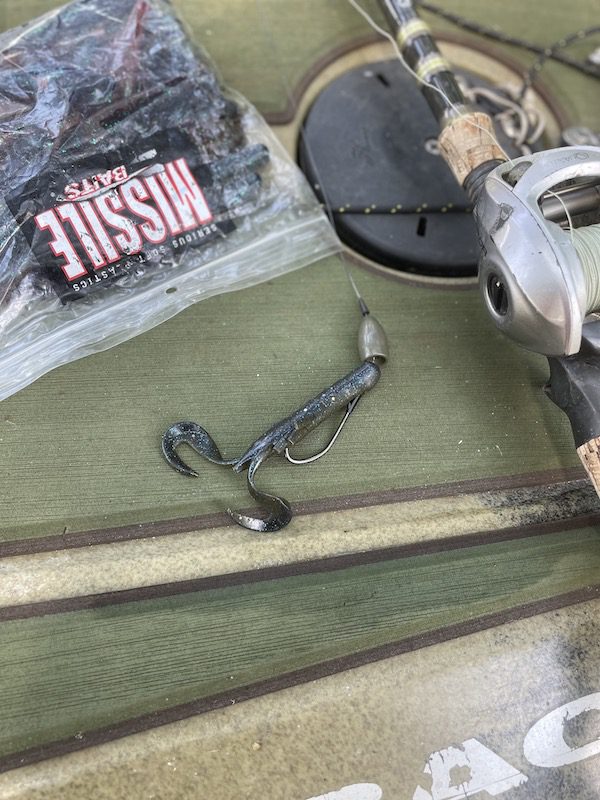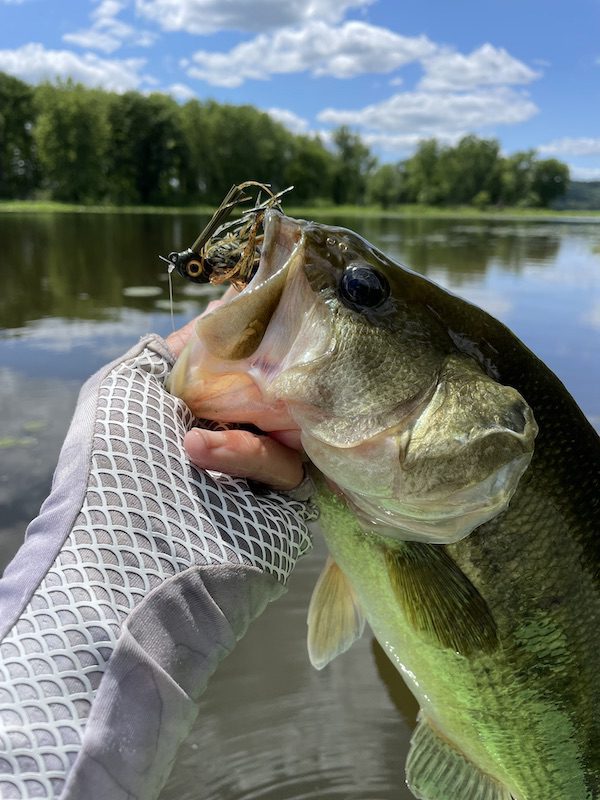Beat the Heat on a Tidal River
Summer is here. Days are long and the weather is warm. For me, it’s time to get out on a river. I’ll still venture out to a reservoir occasionally, but most of my summer fishing is done on moving water. Why do I prefer rivers over a big lake this time of year? The biggest reason is that a large population of the reservoir bass head to deep water once the water temps heat up. There are always some fish shallow, but fishing deep is more effective on most of the lakes I frequent. As I’ve said before, I love to fish shallow, so I gravitate towards places where most of the fish are still in that zone. My other reason for shying away from the big lakes is boaters. Hot summer days bring out the jet skiers, wakeboarders, and other pleasure boaters. I’ve got nothing against these folks. They have a right to share the water, but lakes can get pretty crowded this time of year. The rivers tend to be less trafficked. Non-tidal rivers tend to be too low for big boats. Similarly, tidal rivers, with their tannic water, expansive flats, and abundant vegetation, tend to attract fewer pleasure boaters than highland reservoirs. This makes for a quieter, more peaceful day on the water, and it increases your odds of encountering wildlife, a big bonus for me.
When I hear someone mention river fishing, my mind immediately goes to smallmouth. I picture a rocky stream with ledges, whitewater, and hard-fighting brown fish. There’s nothing that compares with a feisty river smallmouth. Chasing them can be a blast this time of year, but I think they’re already on most everyone’s radar. So, I want to give some attention to a more overlooked resource, tidal rivers. These slower-moving rivers and the green fish that inhabit them can be terrific in the summer.
For many years, I lived just a few minutes’ drive from the tidal Potomac, so I have a deep appreciation for these fish. I’ve spent countless hours chasing them, and they’ve humbled me quite a few times. Tidal systems are typically dominated by largemouth, but there are often smallmouth present in the upper reaches. On the Potomac, for example, there’s fantastic smallmouth fishing above the fall line, but bronzebacks can also be caught in DC waters. I’ve even caught a few below the Woodrow Wilson Bridge. Still, a vast majority of the time, I’m targeting largemouth on a tidal fishery.
Before talking specific baits and techniques, it’s important to understand the tide itself. Essentially, current moves for six hours in one direction. Then there’s a thirty-minute slack period, followed by six hours of current moving the opposite direction. This cycle happens twice a day and it impacts fish positioning. Thankfully there are websites and apps that predict tides for specific locations on the river. They call it predicting because a full moon or high winds can cause unusual variance – higher or lower tide than normal – but most days the charts are extremely accurate. For our region, the difference between high and low tide is roughly two feet.
My favorite time to fish is a falling tide. I especially like the last two hours of outgoing and first two of incoming. The lower water level limits the area where the fish can hide and tends to concentrate them. Picture a giant flat that’s covered with pads. At high tide, they might be over two or three feet of water. Fish could be anywhere. But on low tide, those pads will be in very little water. Fish are almost always holding on the outside edge, closest to deeper water. Conversely, the fish will follow the rising water into cover that was dry a few hours earlier. I’m not sure why this happens, but I’ve caught fish extremely shallow on a high tide. I’ll typically follow the rising water, pushing further onto a flat or deeper into a grassbed until I connect with the fish.
Ever heard of running the tides? If not, don’t worry. It doesn’t work for us because our kayaks can’t travel fast enough. Our most productive strategy is to stay in a general area and fish through all the tides. I’ve heard of guys sitting in a specific spot and making the same cast over and over for hours, but I don’t have the patience for that. I cover a few miles in an average day, and I might visit key spots multiple times as the tides change. Fish move almost constantly with the tides, but I think they go back and forth between prime habitat for the given water level.
So, what are some of these key places to target on a tidal system. Typically, I’m looking for either grass or wood. There are some situations where I’ll target rock or bridge pilings, but I always try to find some type of vegetation first. Milfoil, coontail, hydrilla, spatterdock, and lily pads are all great. In summer these grasses are typically thick. The submergent grasses will reach the surface in many places, completely choking some bays on a low tide. In these areas, I’m looking for a channel, ditch or holes in the grass. I want some kind of variance that the fish can use. Topped out milfoil is by far my favorite scenario. This grass doesn’t grow as thick, so it’s perfect for fishing topwater frogs. When the milfoil strands are taller than the water is deep, they lay over and form a mat on the surface. These mats have open space underneath; they aren’t solid walls like hydrilla. Fish will blast through the canopy to grab a buzzing toad or hollow-bodied frog. I like a Stanley Top Toad or Zoom Horny Toad for covering vast milfoil mats. If I’m targeting isolated clumps, or if I’ve located an area with fish that won’t react to a faster bait, a Strike King Pad Perch can be great. I’ll use a stop and go retrieve with the Pad Perch, varying the length of the pauses. Sometimes they’ll absolutely explode on it after it’s been still for several seconds.

Punching is another fun way to fish matted vegetation. I’ll usually start with a 1 oz weight and go heavier as needed. I try to use the lightest weight that will easily penetrate the canopy. One thing that I do differently from other punchers, I use a relatively light hookset. I’ve found that a jarring hookset isn’t necessary. I still lean into them and try to winch them out of the cover quickly, but I’m not swinging for the fences. I use 50 or 65-pound braided line and an extra heavy 7’6’’ rod. There is very little give in that setup, and my casts are short, usually 10 yards or less. At that range, a jarring hookset can tear a big hole in the fish’s lip, making it easier for the hook to pop out with a head shake. I also think a steady pressure set keeps the big weight from popping the fish’s mouth open, another way we miss fish punching. Like many others, I’ve been using a snell knot on my punching setup for several years. I think the way it makes the hook stand out results in better hookups, but I also caught plenty of fish back when I used a simple palomar knot. When it comes to baits for punching, I keep it simple. A Missile Baits Craw Father in green pumpkin or superbug is my go-to when it’s hot out. It’s a compact lure that slides through the grass more easily than baits with large appendages. It’s also made of durable plastic that doesn’t tear as easily as some others I’ve tried.
When the tide is higher or the grass isn’t quite topped out, I like to pitch plastics with a lighter weight. I’ll focus on isolated clumps, edges, and gaps in the grass. If fish are aggressive, I’ll go with a bulkier creature bait, ½ oz weight, 17 to 20 lb fluoro, and a standard 7’4’’ heavy action rod. The Missile Chunky D hasn’t been around for long, but it’s been good to me so far. It has a prominent thump, which I like when the water is warm. A stickworm, like a Missile Baits Quiver or a Yum Dinger, is another fantastic flipping bait. It’s something that a lot of people don’t use, but it’s extremely effective. I’ve probably caught more Potomac bass pitching a stickworm than any other lure. It has a subtle action that draws strikes when traditional creature baits aren’t working. I like a lighter setup for this technique, often 14 or 15 lb Vicious fluorocarbon, a 1/8 oz weight, and a 7’ medium heavy rod. I’ll sometimes bump up to 17 lb line if the cover is extremely thick, but the 14 is strong enough for most situations.


Let’s stay with the non-topped grass for a minute. If I’m fishing a giant flat and searching for fish, I start with moving baits, especially if there is wind, overcast skies, or rain. Flipping is fun, but it’s slow. I can cover water faster with moving baits like a Z-Man Jackhammer. The Strike King Hybrid Hunter Jr. is a great alternative to the chatterbait. It’s got a different sound and vibration, so I’ll throw it when I see everyone else using a chatterbait. I’ll even go behind myself sometimes, fishing a Hybrid Hunter through the same water I just fished with a chatterbait. A swim jig is another great lure for covering water. A Missile Mini Swim Jig with a Mini D Chunk trailer has some thump, but it’s far more subtle than the vibrating jig or crankbait. Under bluebird skies or no wind situations, the less intrusive bait can be a better choice. Contacting the grass is a big key with all these baits. Changes in retrieve speed can also trigger bites. I’ll rarely just steadily wind a lure back to the kayak. I like to mix in stops and starts, twitches, and little bursts of speed to draw a strike.
In the summertime, I spend a lot of time off the main river in tributaries. I like to push to the very back of a creek – even beyond the reach of the tide – and look for cooler water. This influx of cool water can be a magnet for fish. It’s a similar phenomenon to a spring in a lake. Not every creek is going to be special, but when you find the right one, you can catch a bunch of fish in a hurry. Exploring these hard-to-reach areas is part of the fun. Often the best fishing is in the places that are the hardest to get to.
Spend some time on a tidal river this summer. You can beat the heat, avoid the crowds, and catch some nice fish. Even better, you can do it in water that’s shallow enough to stand in.

